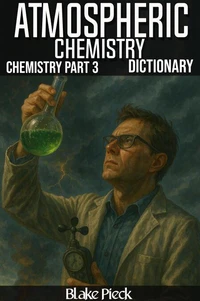Mercury Dictionary. Grow Your Vocabulary
Par :Formats :
Disponible dans votre compte client Decitre ou Furet du Nord dès validation de votre commande. Le format ePub est :
- Compatible avec une lecture sur My Vivlio (smartphone, tablette, ordinateur)
- Compatible avec une lecture sur liseuses Vivlio
- Pour les liseuses autres que Vivlio, vous devez utiliser le logiciel Adobe Digital Edition. Non compatible avec la lecture sur les liseuses Kindle, Remarkable et Sony
 , qui est-ce ?
, qui est-ce ?Notre partenaire de plateforme de lecture numérique où vous retrouverez l'ensemble de vos ebooks gratuitement
Pour en savoir plus sur nos ebooks, consultez notre aide en ligne ici
- FormatePub
- ISBN8227323378
- EAN9798227323378
- Date de parution25/02/2025
- Protection num.pas de protection
- Infos supplémentairesepub
- ÉditeurBig Dog Books, LLC
Résumé
Mercury - Mercury, Terrestrial Planets, Inner Planets - Mercury is the smallest and innermost planet in the Solar System, orbiting closest to the Sun. It has a thin exosphere rather than a true atmosphere, composed of oxygen, sodium, hydrogen, helium, and potassium, making it unable to retain heat. As a result, Mercury experiences extreme temperature variations, with daytime temperatures reaching 430°C (800°F) and nighttime temperatures dropping as low as -180°C (-290°F).
The planet's heavily cratered surface resembles the Moon, with ancient impact basins such as the Caloris Basin, a massive crater over 1, 500 km wide. Mercury has a large iron core, making up nearly 85% of its radius, which contributes to its unexpectedly strong magnetic field. The planet has a 3:2 spin-orbit resonance, meaning it rotates three times for every two orbits around the Sun. Despite its proximity to the Sun, Mercury is not the hottest planet-Venus holds that title due to its dense atmosphere.
Mercury was first visited by NASA's Mariner 10 in the 1970s, which mapped part of its surface, and later by MESSENGER (2004-2015), which provided detailed data on its geology, magnetic field, and potential water ice deposits in permanently shadowed craters. The BepiColombo mission (launched in 2018, arriving in 2025) will further explore Mercury's surface and magnetic properties, continuing efforts to understand its formation and evolution as a terrestrial planet.
The planet's heavily cratered surface resembles the Moon, with ancient impact basins such as the Caloris Basin, a massive crater over 1, 500 km wide. Mercury has a large iron core, making up nearly 85% of its radius, which contributes to its unexpectedly strong magnetic field. The planet has a 3:2 spin-orbit resonance, meaning it rotates three times for every two orbits around the Sun. Despite its proximity to the Sun, Mercury is not the hottest planet-Venus holds that title due to its dense atmosphere.
Mercury was first visited by NASA's Mariner 10 in the 1970s, which mapped part of its surface, and later by MESSENGER (2004-2015), which provided detailed data on its geology, magnetic field, and potential water ice deposits in permanently shadowed craters. The BepiColombo mission (launched in 2018, arriving in 2025) will further explore Mercury's surface and magnetic properties, continuing efforts to understand its formation and evolution as a terrestrial planet.
Mercury - Mercury, Terrestrial Planets, Inner Planets - Mercury is the smallest and innermost planet in the Solar System, orbiting closest to the Sun. It has a thin exosphere rather than a true atmosphere, composed of oxygen, sodium, hydrogen, helium, and potassium, making it unable to retain heat. As a result, Mercury experiences extreme temperature variations, with daytime temperatures reaching 430°C (800°F) and nighttime temperatures dropping as low as -180°C (-290°F).
The planet's heavily cratered surface resembles the Moon, with ancient impact basins such as the Caloris Basin, a massive crater over 1, 500 km wide. Mercury has a large iron core, making up nearly 85% of its radius, which contributes to its unexpectedly strong magnetic field. The planet has a 3:2 spin-orbit resonance, meaning it rotates three times for every two orbits around the Sun. Despite its proximity to the Sun, Mercury is not the hottest planet-Venus holds that title due to its dense atmosphere.
Mercury was first visited by NASA's Mariner 10 in the 1970s, which mapped part of its surface, and later by MESSENGER (2004-2015), which provided detailed data on its geology, magnetic field, and potential water ice deposits in permanently shadowed craters. The BepiColombo mission (launched in 2018, arriving in 2025) will further explore Mercury's surface and magnetic properties, continuing efforts to understand its formation and evolution as a terrestrial planet.
The planet's heavily cratered surface resembles the Moon, with ancient impact basins such as the Caloris Basin, a massive crater over 1, 500 km wide. Mercury has a large iron core, making up nearly 85% of its radius, which contributes to its unexpectedly strong magnetic field. The planet has a 3:2 spin-orbit resonance, meaning it rotates three times for every two orbits around the Sun. Despite its proximity to the Sun, Mercury is not the hottest planet-Venus holds that title due to its dense atmosphere.
Mercury was first visited by NASA's Mariner 10 in the 1970s, which mapped part of its surface, and later by MESSENGER (2004-2015), which provided detailed data on its geology, magnetic field, and potential water ice deposits in permanently shadowed craters. The BepiColombo mission (launched in 2018, arriving in 2025) will further explore Mercury's surface and magnetic properties, continuing efforts to understand its formation and evolution as a terrestrial planet.























